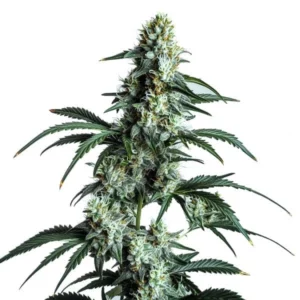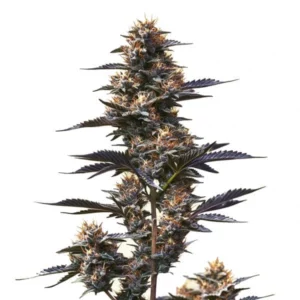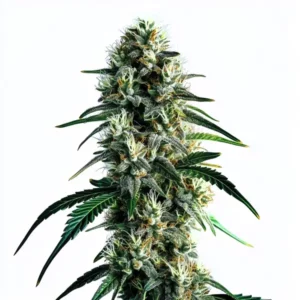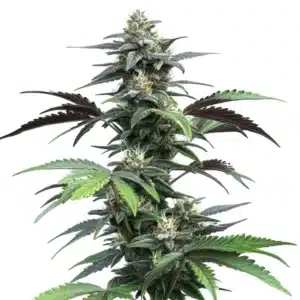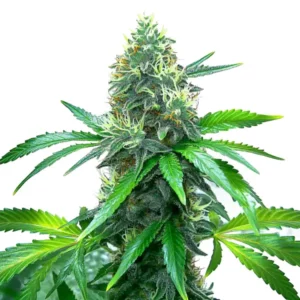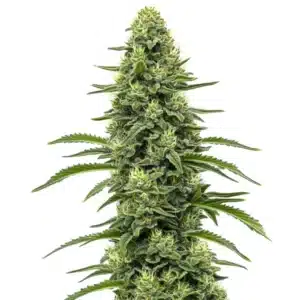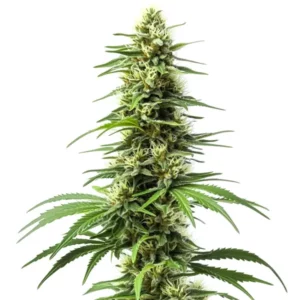
Using Transpiration Data to Optimize Cannabis Feeding Schedules
Every cannabis grower knows how crucial it is to get the feeding schedule just right. Using transpiration data to optimize cannabis feeding schedules offers a data-driven approach to achieving this goal. Transpiration is the process where plants release water vapor through small openings in their leaves. By analyzing transpiration rates in cannabis cultivation, growers can fine-tune their feeding strategies.
Transpiration helps plants draw in water and nutrients from their roots. When you understand how much water your cannabis plants are releasing, you can adjust nutrient levels accordingly. This ensures that plants receive the right amount of nutrients without over or underfeeding. It’s all about balance, and using transpiration data for cannabis nutrient management can make this balance easier to achieve.
Recommended Strains
Sour Diesel
|
|
THC | 22% - 25% (Medium) |
|
|
Type | Feminized |
|
|
Yield | High |
|
|
Phenotype | 30% Indica / 70% Sativa |
Girl Scout Cookies
|
|
THC | 18% - 25% (Medium) |
|
|
Type | Feminized |
|
|
Yield | High |
|
|
Phenotype | 60% Indica / 40% Sativa |
Real-life examples prove the efficacy of this approach. Imagine growing a strain like Sour Diesel from Blimburn Seeds. By monitoring transpiration, you can tailor the feeding schedule to the plant’s specific needs, enhancing its growth and ultimately, its yield.
How Transpiration Data Can Improve Cannabis Growth
Improving cannabis growth with transpiration insights involves monitoring how much water your plants are losing. This data is crucial for knowing the plant’s water use efficiency. When you have this information, you can make informed decisions about watering and feeding, ensuring your plants are always in optimal health.
For example, if a plant shows high transpiration rates, it might need more water and nutrients to maintain its growth. On the other hand, low rates could indicate overwatering or nutrient lockout. Strains like Girl Scout Cookies from Blimburn Seeds can benefit from this precise nutrient management, resulting in healthier plants and better yields.
Using transpiration data to optimize cannabis feeding schedules not only enhances growth but also boosts resistance to stressors. Plants that are well-nourished can better withstand environmental challenges such as temperature fluctuations. By continuously analyzing transpiration rates in cannabis cultivation, growers can ensure their plants have the resilience needed to thrive.
Moreover, transpiration data helps in identifying the ideal microclimatic conditions for your cannabis plants. This includes adjusting variables like light exposure and air circulation. When all factors are optimally aligned, plants can photosynthesize more efficiently, converting more energy into growth. This comprehensive approach ensures that the plant’s potential is fully realized.
Promos & Deals
Analyzing Transpiration Rates in Cannabis Cultivation
Analyzing transpiration rates in cannabis cultivation involves using tools like hygrometers and digital sensors. These tools provide real-time data on humidity levels and temperature, both of which affect transpiration. High humidity can slow down transpiration, while high temperatures can increase it.
Once you have a grasp on these rates, you can adjust your environment to suit the needs of your plants. For instance, a strain like Blue Dream from Blimburn Seeds might need a different humidity level compared to other strains. By using transpiration data, you can create the perfect environment for each specific strain.
Regularly analyzing transpiration rates in cannabis cultivation can also predict potential nutrient deficiencies before they become visible. By correlating transpiration data with nutrient uptake, growers can preemptively amend their feeding solutions to prevent any imbalance. This proactive nutrient management is key to maintaining plant vigor and maximizing output.
Additionally, the data collected from transpiration monitoring can aid in developing a more sustainable cultivation practice. By knowing the exact water needs of each strain, growers can reduce water wastage, contributing to environmentally friendly growing methods. This precision in resource use is an advantage not only for the grower but also for the planet.

Transpiration Monitoring for Efficient Cannabis Feeding
Transpiration monitoring for efficient cannabis feeding involves regularly checking transpiration levels and adjusting feeding schedules based on the data. This proactive approach helps prevent common issues like nutrient burn or deficiency, which can severely affect plant health and yield.
One practical example is adjusting nutrient solutions based on the stage of plant growth. During the vegetative stage, plants often transpire more, requiring additional nutrients. Conversely, during flowering, the requirements might decrease. Regular monitoring allows for these adjustments, ensuring that plants like OG Kush from Blimburn Seeds thrive throughout their life cycle.
By monitoring transpiration rates closely, growers can also enhance the flavor profile and potency of their cannabis strains. Different nutrient levels can affect the terpenes and cannabinoids composition in the plant, and precise adjustments can lead to higher-quality yields. This is where cannabis feeding schedule optimization using transpiration truly shines, offering both quantity and quality improvements.
Moreover, consistent transpiration monitoring for efficient cannabis feeding helps in identifying and mitigating pest and disease outbreaks. Plants that are not stressed by nutrient imbalances are less susceptible to infestations and infections. Thus, maintaining optimal feeding schedules contributes to overall plant health and yield security.
Practical Steps for Cannabis Feeding Schedule Optimization Using Transpiration
Start by investing in reliable tools for monitoring transpiration rates. These could be simple digital hygrometers or more advanced systems integrated with climate control equipment. Regularly check these readings and record the data for analysis.
Next, create a baseline by observing how different strains respond to varying levels of humidity and temperature. This helps in setting a standard for what works best for each strain. As you gather more data, use it to adjust feeding schedules, ensuring that each plant receives the nutrients it needs based on its transpiration rate.
Another key step in cannabis feeding schedule optimization using transpiration is to regularly update your baseline data. As environmental conditions change with seasons, adjustments may be necessary to maintain plant health. By staying informed, you can implement seasonal adjustments without disrupting plant growth.
Furthermore, consider integrating technology that automates the data collection and adjustment processes. This not only saves time but also reduces the chance of human error in managing feeding schedules. Automation can provide real-time feedback, allowing you to make quick adjustments and maintain optimal growth conditions consistently.

FAQs about Using transpiration data to optimize cannabis feeding schedules
How does transpiration affect cannabis feeding schedules?
Transpiration plays a critical role in how plants absorb water and nutrients. By using transpiration data to optimize cannabis feeding schedules, growers can ensure that the plants receive the right amount of nutrients at the right time. This process helps avoid issues such as over or underfeeding, which can lead to poor plant health and reduced yields.
Monitoring transpiration allows for a more precise adjustment of feeding schedules. For instance, if a plant is losing a lot of water, it might require more nutrients to maintain its growth. Conversely, if transpiration rates are low, it may indicate the need to reduce nutrient levels to prevent nutrient lockout.
Transpiration data for cannabis nutrient management also provides insights into the overall health of the growing environment. If transpiration rates are consistently off, it could indicate broader issues with humidity control or nutrient formulation. This knowledge empowers growers to make necessary environmental adjustments proactively.
Additionally, knowing the relationship between transpiration and feeding can help in developing more efficient irrigation systems. By aligning watering schedules with actual plant needs, growers can conserve resources and improve the sustainability of their cultivation practices.
What tools are required for analyzing transpiration in cannabis cultivation?
To effectively analyze transpiration in cannabis cultivation, growers need tools like hygrometers, which measure humidity, and temperature sensors. These tools help in knowing the environmental factors that affect transpiration rates. More advanced setups might include integrated climate control systems that automatically adjust conditions based on real-time data.
Using these tools, growers can gather valuable insights into how environmental conditions influence transpiration. This data is crucial for making informed decisions about watering and feeding schedules, ensuring plants receive the optimal amount of nutrients.
Besides to basic tools, employing data management software can streamline the process of analyzing and applying transpiration data. These platforms often offer visual analytics and trend predictions, making it easier to identify patterns and make informed adjustments to feeding schedules.
Some growers might also use leaf porometers or stomatal conductance meters to get direct readings on leaf transpiration. These specialized tools provide real-time feedback on how environmental changes are impacting transpiration at a physiological level, offering a deeper knowing of plant needs.
Can all cannabis strains benefit from transpiration monitoring?
Yes, all cannabis strains can benefit from transpiration monitoring. Each strain has its own unique needs in terms of water and nutrient uptake. By monitoring transpiration, growers can tailor their feeding schedules to suit the specific requirements of each strain, leading to healthier plants and improved yields.
For example, a strain like Sour Diesel might have different transpiration needs compared to Blue Dream. By closely monitoring these needs, growers can adjust their approach, ensuring that each strain achieves its full potential.
Even within a single strain, variations in phenotype can result in differing transpiration requirements. By observing these differences, growers can customize their approach even further, maximizing the genetic potential of each plant.
Transpiration monitoring also aids in long-term strain development. By knowing how different strains respond to environmental conditions, breeders can select for traits that enhance water use efficiency, leading to more resilient and productive cannabis varieties.
How often should transpiration data be collected for effective feeding schedule optimization?
For optimal results, transpiration data should be collected regularly. Daily monitoring is ideal, especially during critical growth phases such as the vegetative and flowering stages. This ensures that any changes in transpiration rates are quickly identified and addressed.
Regular data collection allows growers to make timely adjustments to their feeding schedules, preventing issues before they arise. This proactive approach is key to maintaining plant health and maximizing yield potential.
Besides, frequent data collection provides a comprehensive dataset that can be used for predictive analytics in future grows. Analyzing these trends can reveal insights into seasonal variations and help in planning for future cultivation cycles.
Moreover, consistent data collection can uncover subtle shifts in plant physiology that might indicate the onset of stress or disease. Early detection through transpiration data can facilitate swift intervention, preserving plant health and yield.
What are some common mistakes when using transpiration data for cannabis nutrient management?
One common mistake is relying solely on transpiration data without considering other environmental factors like light intensity and soil health. While transpiration data is valuable, it should be used as part of a comprehensive approach to cannabis cultivation that includes monitoring all aspects of the growing environment.
Another mistake is failing to adjust feeding schedules based on the specific needs of different strains. It’s important to remember that each strain has unique requirements. By closely monitoring transpiration and adjusting accordingly, growers can avoid these pitfalls and ensure a successful harvest.
Ignoring the dynamic nature of the growing environment is another potential oversight. Conditions can change rapidly, and without frequent monitoring, growers might miss critical adjustments needed for optimal growth. Regular checks are essential for effective transpiration-based management.
Lastly, not documenting all changes and observations can lead to repeated errors. Maintaining detailed records not only aids in adjusting current grows but also serves as a valuable reference for future cultivation cycles. This practice ensures that lessons learned are not lost but built upon.


